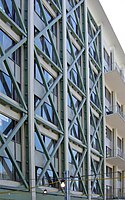
Photo from wikipedia
Abstract Intermediate crack (IC) debonding is a common failure mode of externally bonded (EB) FRP-strengthened RC beams. This debonding failure initiates at an intermediate crack and propagates towards a plate… Click to show full abstract
Abstract Intermediate crack (IC) debonding is a common failure mode of externally bonded (EB) FRP-strengthened RC beams. This debonding failure initiates at an intermediate crack and propagates towards a plate end. New epoxy anchor was proposed recently by the authors and has shown its effectiveness in enhancing interfacial bonding behaviour and therefore it might be effective to delay or suppress IC debonding failure in RC beams. This study is to experimentally investigate the efficiency of using epoxy anchors for mitigating the IC debonding under three-point bending tests. The application of the new proposed epoxy anchors has advantage of simple installation procedure including pre-drilling holes and then bonding FRP. Totally, five RC beams including one control specimen and four anchored ones were tested. Damage modes and structural response of unanchored and anchored RC beams were evaluated and discussed. The effects of various configurations of epoxy anchors were analysed and discussed. The experimental results show that the load-carrying capacity and the ductility of anchored beams increased by up to 13.12% and 53.31%, respectively, and the strain utilization of FRP can be significantly improved by 43.48% as compared to the control specimen.
Journal Title: Engineering Structures
Year Published: 2021
Link to full text (if available)
Share on Social Media: Sign Up to like & get
recommendations!